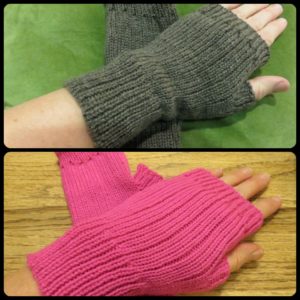Making Mitts on the CSM
 So far I’ve made two sets of mitts on my circular sock machine and they are quickly becoming my favorite project. There are no heels to turn and they are smaller than a sock so there is less cranking. I make a hole for the thumb using this technique and do a bit of hand work to finish them with a hand knit thumb which is a comfortable thing for me to do as a hand knitter. They have also taught me a lot about using my ribber.
So far I’ve made two sets of mitts on my circular sock machine and they are quickly becoming my favorite project. There are no heels to turn and they are smaller than a sock so there is less cranking. I make a hole for the thumb using this technique and do a bit of hand work to finish them with a hand knit thumb which is a comfortable thing for me to do as a hand knitter. They have also taught me a lot about using my ribber.
You can take a look at the checklist I developed to make these mitts. I’ve been using checklists like this for my projects because they help me remember to do all the steps for both items in a pair, and if I’m pulled away from the machine by family needs, I know where I am when I can return.
Since the mitts are ribbed from top to bottom and require starting with the ribber and then changing to less ribber needles and then back to more ribber needles, I had to really get more comfortable with my ribber. In no particular order, here are some things that helped me:
- Slow down! Stockinette on all cylinder needles pretty much behaves itself at all speeds as long as your tension is right and the yarn is feeding correctly. At least on my machine, when the ribber and cylinder needles start working together, I need to slow down so the yarn feeds back and forth between those needles evenly.
- Watch the first round or two carefully after switching needle formations. In addition to going more slowly, I carefully watched each needle close around the yarn after putting in the new needles. Although I carefully check the latches to make sure they are open, by watching each needle, I can make sure each one is going to do its job and I didn’t accidentally brush a latch closed somewhere.
- Learn to do the needle transfers from cylinder to ribber as shown here. At first I was using a pick tool to move the stitches and it stretches them out just enough that they were more prone to dropping. This method leaves the stitch tight on the new needle.
- Watch the latches carefully when switching to and from waste yarn. The other place I would drop stitches was when moving between waste yarn and project yarn because the knot would get in the way of a needle latch or the long tail pulled into the cylinder would change the angle of the yarn. So I’ve learned to watch those areas carefully and help the yarn into a latch if it misses.
(Some of the links in this post are to Ravelry forums. If you are working with a circular sock machine, there are several friendly and helpful groups on Ravelry– and joining Ravelry is free!)